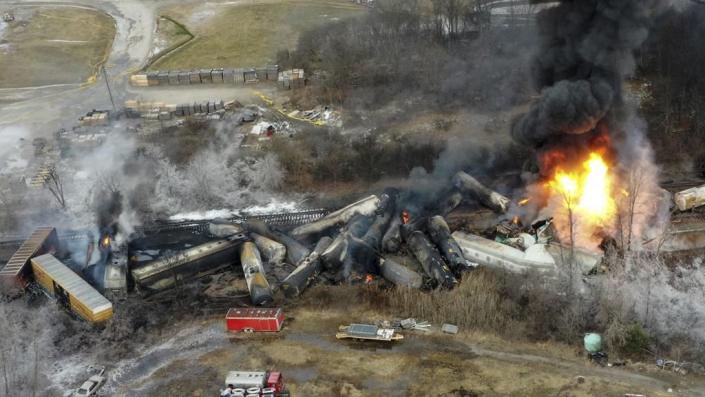IT'S A MYTHOpinion: Carbon capture and storage a good deal for Canada and the world
Opinion by James Millar • Friday
As we await further details on support for carbon capture and storage (CCS) projects in the upcoming federal budget, there are almost daily reports expressing concern that Canada is losing ground to the United States and other competitors when it comes to breaking ground on large-scale CCS facilities.

Pipes run through a carbon capture facility in Alberta. © Provided by Calgary Herald
Canada and the European Union are indeed scrambling to craft policies promoting private-sector investment in CCS following the landmark incentives put in place in the U.S. late last year. The United Kingdom has also doubled down with last week’s announcement of a CAD $33-billion investment in CCS for the next 20 years. Getting the right framework built, and quickly, is critical as the clock is ticking on Canada’s commitment to reach net-zero greenhouse gas emissions by 2050. Meeting this goal will rely heavily on implementing CCS in heavy industries across the country, including power generation; cement, steel and fertilizer manufacturing, mining, petrochemical processing, and oil and gas production.
While much attention is on the hefty upfront price tag for building large-scale CCS infrastructure, what is often lost in the debates over how to create the right conditions for investment in CCS are the longer-term costs to our society if we do not proceed on pace with the massive build-out required if we hope to meet our Paris Agreement commitments.
At the highest level, the world can’t afford to ignore CCS as a key tool in fighting climate change. The International Energy Agency estimates that CCS will be required for as much as one-quarter of the GHG reductions necessary by 2050, while the UN’s Intergovernmental Panel on Climate Change forecasts that the cost of climate mitigation could more than double without the application of CCS technologies.
It is also important to look beyond the direct cost of building a CCS facility, and consider how the cost of CCS impacts end users of the products we all rely on for daily life. A new study by Norwegian and Dutch experts concluded that implementing CCS on large-scale industrial projects yields significant CO2 reductions at minimal cost to the public over the long term. The researchers concluded that CCS is a relatively cheap emissions reduction solution for the end users of the commodities that heavy-emitting industries provide. After all, the average person does not tend to buy a lot of steel, cement, fertilizer or crude oil, but we do rely on these inputs for our homes, buildings, roads, clothing, food, pharmaceuticals and electronic devices. It turns out the overall cost for mitigating CO2 emissions from these products with CCS is marginal and well within the normal range of variation we see in market prices for such goods.
Focusing on the situation in Canada, our current federal emissions reduction plan calls for more than tripling Canada’s current CCS capacity by 2030. Adding the capture facilities, pipelines and underground storage systems needed for keeping at least another 15 million tonnes of CO2 per year from entering the atmosphere by the end of the decade is a massive undertaking that will require enormous political will, public confidence, and collaboration between industry, government, academia, Indigenous communities, and other partners.
Related video: Pressure grows on the shipping industry to accept carbon levy (WION) View on Watch
The major players in Canada’s heavy-emitting industries – which provide major contributions to national GDP and government revenues, employ millions of people, and include firms that are at the core of most Canadians’ pension plans and investment portfolios – are committed to achieving net zero by 2050, and they are set to invest billions in Canada. Capital Power announced last December a limited notice to proceed for its Genesee CCS project. Heidelberg Materials continues to advance the world’s first CCS project on a cement plant in Edmonton. And the oilsands industry is already spending tens of millions of dollars on environmental assessments, early-stage engineering work and stakeholder engagement that is necessary to receive permits for construction.
All heavy emitters are awaiting key details to be released in the March 28 budget for how the Government of Canada will create a competitive regulatory environment with co-financing models allowing for multi-decade investments that will be tenable through the volatile cash flows that can define industry, especially the oil and gas sector.
Canada’s federal government has already lined up significant support for CCS projects through a proposed investment tax credit, new capital cost allowance classes for CCS projects, a federal price on carbon emissions, and several federal and provincial carbon credit systems that will allow companies to monetize the emissions they permanently send underground. When taken together, these incentives provide a promising basis for CCS investment in Canada.
The focus now needs to be on ensuring these programs move from proposals to reality, and for the government to provide long-term certainty on its carbon pricing regime so that industry can be confident its economic models won’t collapse due to the shifting winds of climate politics in the decades to come.
In the meantime, the risk that capital available for CCS development will move south of the border continues to grow. The U.S. Inflation Reduction Act contained straightforward incentives for CCS, including a production tax credit that provides $85 for every tonne of CO2 captured – a juicy carrot analysts believe will cover two-thirds of a project’s lifetime capital and operating costs.
As the world’s good intentions for addressing climate change become concrete plans with dollar figures attached, some argue that funding for the energy transition be directed towards renewable power and other emissions reduction technologies, but not CCS. This is an unrealistic approach considering the magnitude of the challenge ahead.
To be clear, global decarbonization requires using all the tools we have at our disposal. CCS is the only proven solution we have today that can dramatically cut CO2 emissions from heavy industries that are the pillars of our economy. It is worth pointing out that investment in this emission reduction pathway has been virtually non-existent compared to the trillions of dollars that have been spent on wind turbines, solar panels, electric vehicles and energy efficiency programs so far this century – during which time greenhouse gas emissions have continued to climb and the share of fossil fuels in the world’s energy mix has only budged marginally from 87 per cent in 2000 to 84 per cent by 2020.
It’s time to bring CCS to life, and Canada is uniquely suited to capture enormous value from the CCS boom on the horizon. With the right geology for safely storing CO2 deep underground, the technical experience from building and operating many of the world’s first CCS facilities, and the desire to fight climate change in a just and sustainable manner, Canada is poised to continue its global leadership in the CCS space.
Let’s make sure we don’t miss out on this once-in-a-generation opportunity. Our children are counting on us.
James Millar is president and CEO of the International CCS Knowledge Centre.
Carbon Capture Technology And Its Growing Role in Decarbonisation
Editor OilPrice.com
Sat, March 25, 2023
With a greater number of climate policies coming into place worldwide, from the Biden Administration’s IRA to the European Union’s New Green Deal, companies are feeling mounting pressure to decarbonise. And while some are doing it to enhance their ESG practices and futureproof their business, others are concerned about rising carbon taxes, which could slash their profits. So, as well as introducing green energy technology, many are turning to carbon capture and storage (CCS) technologies to support their decarbonisation efforts. Big Oil is pumping billions into CCS equipment at operations around the globe to keep production ‘low-carbon oil’, while other industries, such as manufacturing, are looking to the technology to help clean up operations.
The International Energy Agency (IEA) sees CCS technology as key to the decarbonisation of fossil fuel operations and industrial processes, particularly useful as a bridge to greater renewable energy production. By 2021, the total annual carbon capture capacity stood at close to 45?Mt?of CO2, a figure that is expected to increase substantially with approximately 300 projects under construction. CCS equipment could capture more than 220 Mt CO2 a year by 2030. This will help companies achieve net-zero ambitions when paired with renewable energy technologies.
By 2022, 35 commercial facilities were using CCS for industrial processes, fuel transformation, and power generation. Deployment of the technology has been slow to date but investment in the sector is rising sharply, as companies look for ways to reduce their carbon output, improve their ESG practices, and avoid carbon taxes, to support a green transition. However, improved political policies and regulatory frameworks are required to ensure the effective rollout of the technology, in line with climate policies.
According to research by Wood Mackenzie, 2023 will be a milestone year for CCS. The global CCS pipeline rose by more than 50 percent in 2022, with projects planned across several industrial sectors. In recent years, government funding of up to 50 percent has helped CCS projects get off the ground, a trend that is expected to continue. The U.S. government has so far committed $3.7 billion to finance CCS projects and meet its net-zero goal by 2050. The introduction of new climate policies worldwide will also support the uptake of the technology.
In terms of how the CO2 is used, much of the sequestered carbon is currently going to enhanced oil recovery operations at present, responding to the ongoing need for fossil fuels to ensure energy security worldwide. However, as green energy capacity increases worldwide, much of the CO2 will go to designated storage sites, with 66 percent expected to be pumped deep underground by 2030. New legislation and supporting incentives for CO2 utilisation will encourage this change.
David Lluis Madrid, the CCUS analyst at BloombergNEF (BNEF), explained, “CCS is starting to overcome its bad reputation.” Madrid added, “It is now being deployed as a decarbonization tool, which means the CO2 needs to be stored. A lack of CO2 transport and storage sites near industrial or power generation point sources could be a major bottleneck to CCS development. But we are already seeing a big increase in these projects to serve that need.”
One of many projects underway globally is an innovative CCS offshore site, the Greensand project, in the Danish part of the North Sea, where construction began this month. CO2 captured in Belgium will be transported via ship for injection in a depleted oil field, located 120 miles from the North Sea coast. The project is being undertaken by a consortium of companies including Germany’s Wintershall Dea and Britain’s INEOS. It is considered to be the world’s first cross-border offshore carbon dioxide storage with the explicit purpose of tackling climate change.
Meanwhile, in Norway, a joint venture between Equinor, TotalEnergies, and Shell is also underway. The Northern Lights project will see 1.5 million tonnes of CO2 injected into saline aquifer near the Troll gas field annually, starting in 2024. In the U.K., the Accorn CCS project is being launched off the coast of Scotland, aimed at creating an annual capacity of 5-10 mtpa of CO2 by 2030. The project is being operated by Storegga, Shell, Harbour Energy and North Sea Midstream Partners. And in the Netherlands, the Porthos project by the Port of Rotterdam, Gasunie, and EBN is expected to provide a storage capacity of 2.5 mtpa of CO2. Porthos will be located in depleted Dutch gas fields in the North Sea, with operations expected to start in 2026.
Many companies worldwide are now looking to CCS technologies to help them achieve decarbonisation aims without giving up on their traditional operations. The rollout of CCS around the globe will be supported by new climate policies, decarbonisation incentives, and better regulation of the industry. In addition, greater public funding for CCS projects is expected to spur private investment in the sector and boost the world’s CO2storage capacity significantly in the coming decades.
By Felicity Bradstock for Oilprice.com






.jpg)













